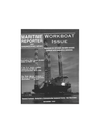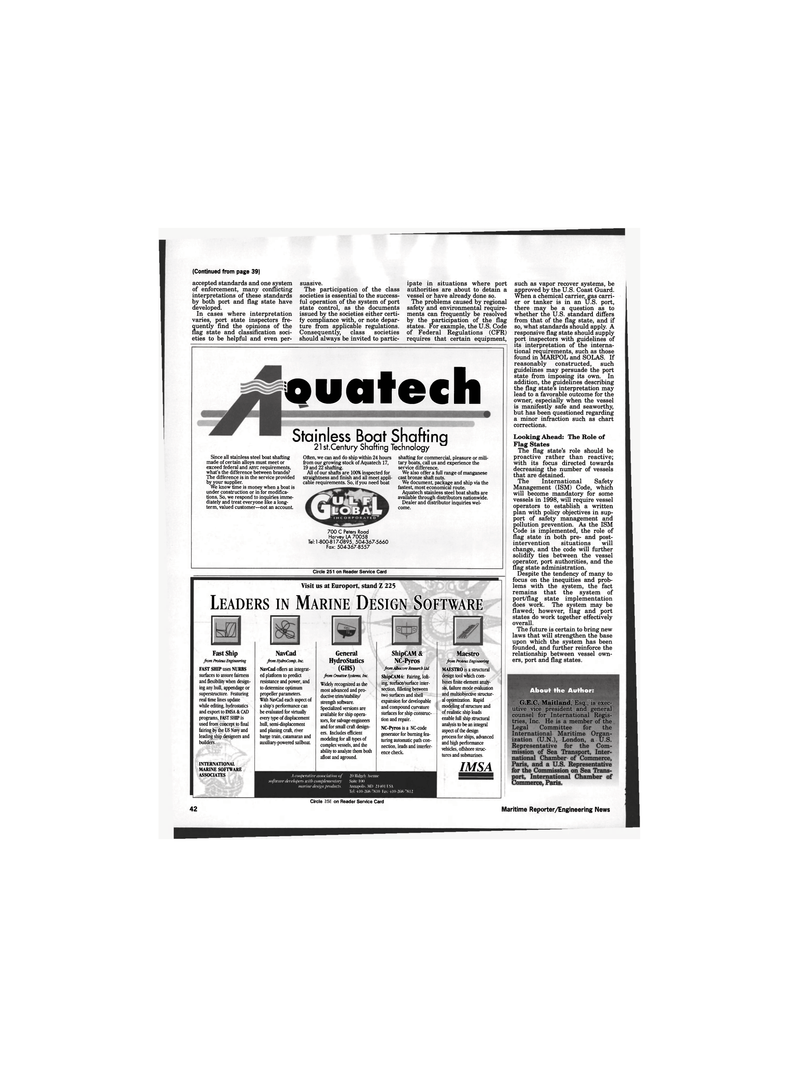
Page 40: of Maritime Reporter Magazine (November 1995)
Read this page in Pdf, Flash or Html5 edition of November 1995 Maritime Reporter Magazine
(Continued from page 39) accepted standards and one system of enforcement, many conflicting interpretations of these standards by both port and flag state have developed.
In cases where interpretation varies, port state inspectors fre- quently find the opinions of the flag state and classification soci- eties to be helpful and even per- suasive.
The participation of the class societies is essential to the success- ful operation of the system of port state control, as the documents issued by the societies either certi- fy compliance with, or note depar- ture from applicable regulations.
Consequently, class societies should always be invited to partic- ipate in situations where port authorities are about to detain a vessel or have already done so.
The problems caused by regional safety and environmental require- ments can frequently be resolved by the participation of the flag states. For example, the U.S. Code of Federal Regulations (CFR) requires that certain equipment, ouatech
Stainless Boat Shafting 21 st.Century Shafting Technology
Since all stainless steel boat shafting made of certain alloys must meet or exceed federal and ABYC requirements, what's the difference between brands?
The difference is in the service provided by your supplier.
We know time is money when a boat is under construction or in for modifica- tions. So, we respond to inquiries imme- diately and treat everyone like a long- term, valued customer—not an account
Often, we can and do ship within 24 hours from our growing stock of Aquatech 17, 19 and 22 shafting.
All of our shafts are 100% inspected for straightness and finish and all meet appli- cable requirements. So, if you need boat shafting for commercial, pleasure or mili- tary boats, call us and experience the service difference.
We also offer a full range of manganese cast bronze shaft nuts.
We document, package and ship via the fastest, most economical route.
Aquatech stainless steel boat shafts are available through distributors nationwide.
Dealer and distributor inquiries wel- come. 700 C Peters Road
Harvey LA 70058
Tel: 1-800-817-0895, 504-367-5660
Fax: 504-367-8557
Circle 251 on Reader Service Card
Visit us at Europort, stand Z 225
LEADERS IN MARINE DESIGN SOFTWARE
Fast Ship from Proteus Engineering
FAST SHIP uses NURBS surfaces to assure fairness and flexibility when design- ing any hull, appendage or superstructure. Featuring real time lines update while editing, hydrostatics and export to IMSA & CAD programs, FAST SHIP is used from concept to final fairing by the US Navy and leading ship designers and builders.
INTERNATIONAL
MARINE SOFTWARE
ASSOCIATES
NavCad from HydroComp, Inc.
NavCad offers an integrat- ed platform to predict resistance and power, and to determine optimum propeller parameters.
With NavCad each aspect of a ship's performance can be evaluated for virtually every type of displacement hull, semi-displacement and planing craft, river barge train, catamaran and auxiliary-powered sailboat.
General
Hydrostatics (GHS) from Creative Systems, Inc.
Widely recognized as the most advanced and pro- ductive trim/stability/ strength software.
Specialized versions are available for ship opera- tors, for salvage engineers and for small craft design- ers. Includes efficient modeling for all types of complex vessels, and the ability to analyze them both afloat and aground.
ShipCAM &
NC-Pyros from Albacore Research Ltd
ShipCAM4: Fairing, loft- ing, surface/surface inter- section, filleting between two surfaces and shell expansion for developable and compound curvature surfaces for ship construc- tion and repair.
NC-Pyros is a NC-code generator for burning fea- turing automatic path con- nection, leads and interfer- ence check.
Maestro from Proteus Engineering
MAESTRO is a structural design tool which com- bines finite element analy- sis, failure mode evaluation and multiobjective structur- al optimization. Rapid modeling of structure and of realistic ship loads enable full ship structural analysis to be an integral aspect of the design process for ships, advanced and high performance vehicles, offshore struc- tures and submarines.
IMSA
A coo/Krai ire association of software developers with complementary marine design products. 20 Ridgely Avenue
Suite 100
Annapolis, Ml) 21401 USA
Tel: 410-268-7810 Fax: 410-268-7812 such as vapor recover systems, be approved by the U.S. Coast Guard.
When a chemical carrier, gas carri- er or tanker is in an U.S. port, there may be a question as to whether the U.S. standard differs from that of the flag state, and if so, what standards should apply. A responsive flag state should supply port inspectors with guidelines of its interpretation of the interna- tional requirements, such as those found in MARPOL and SOLAS. If reasonably constructed, such guidelines may persuade the port state from imposing its own. In addition, the guidelines describing the flag state's interpretation may lead to a favorable outcome for the owner, especially when the vessel is manifestly safe and seaworthy, but has been questioned regarding a minor infraction such as chart corrections.
Looking Ahead: The Role of
Flag States
The flag state's role should be proactive rather than reactive; with its focus directed towards decreasing the number of vessels that are detained.
The International Safety
Management (ISM) Code, which will become mandatory for some vessels in 1998, will require vessel operators to establish a written plan with policy objectives in sup- port of safety management and pollution prevention. As the ISM
Code is implemented, the role of flag state in both pre- and post- intervention situations will change, and the code will further solidify ties between the vessel operator, port authorities, and the flag state administration.
Despite the tendency of many to focus on the inequities and prob- lems with the system, the fact remains that the system of port/flag state implementation does work. The system may be flawed; however, flag and port states do work together effectively overall.
The future is certain to bring new laws that will strengthen the base upon which the system has been founded, and further reinforce the relationship between vessel own- ers, port and flag states.
About the Author
G.E.C. Maitland, Esq., is exec- utive vice president and general counsel for International Regis- tries, Inc. He is a member of the
Legal Committee for the
Internationa] Maritime Organ- ization (U.N.), London, a U.S.
Representative for the Com- mission of Sea Transport, Inter- national Chamber of Commerce,
Paris, and a U.S. Representative for the Commission on Sea Trans- port, International Chamber of
Commerce, Paris.
Circle 303 on Reader Service Card 42 Maritime Reporter/Engineering News

 39
39

 41
41
